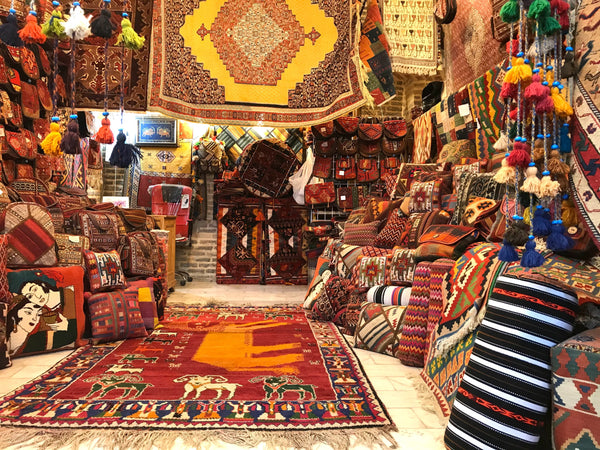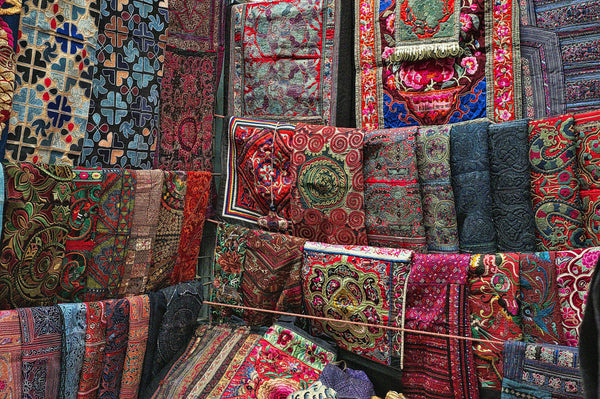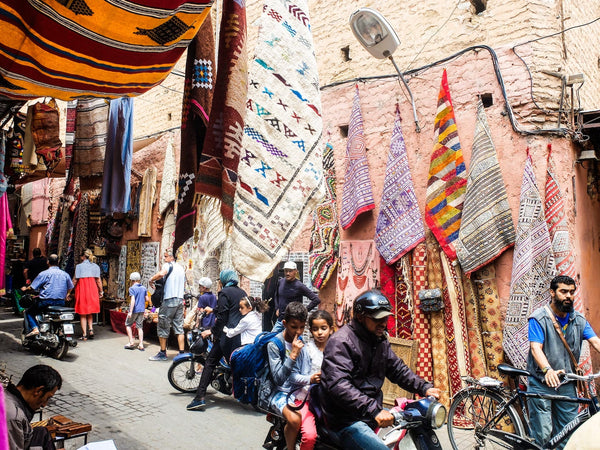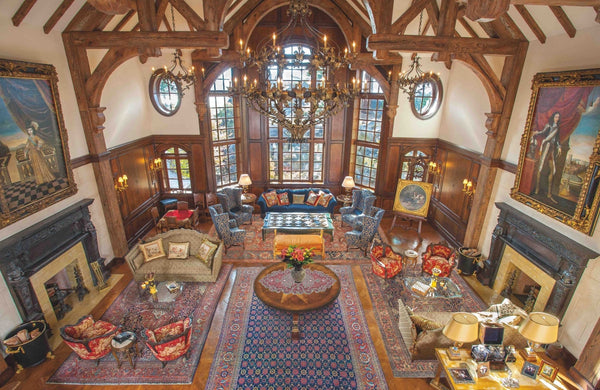Are you looking for a hand-knotted carpet that can add beauty, warmth, and value to your home? If so, you may have heard of Persian rugs and Oriental rugs. But do you know what they are and how they differ? In this article, we will explain everything you need to know about Persian and Oriental rugs and help you choose the best carpet for your home.
What are Persian Rugs and Oriental Rugs?
Persian rugs and Oriental rugs are both hand-knotted carpets that are made in Asia. They have a long history and a rich cultural heritage. However, they differ in their origin, design, and knotting technique.

A Persian rug store in Shiraz, Iran
Persian Rugs:
Persian rugs are made in Iran only. Iran is widely regarded as the birthplace of carpet weaving, with a history that dates back to over 2,500 years ago. Persian rugs are renowned for their intricate designs, rich colors, and high knot density. They use either Persian knots or Turkish knots, which are different ways of tying the wool or silk yarns around the warp threads. Persian rugs have various regional styles, such as Tabriz, Bidjar, Mashad, and Kashan.
Check out our curated collection of Persian Rugs

A rug store in Turkey
Oriental Rugs:
Oriental rugs are made in various Asian countries. They include Persian rugs and rugs from other countries such as Turkey, China, India, Morocco, and Afghanistan. Oriental rugs have diverse designs, colors, and knot densities depending on the region and culture. They use either Turkish knots or Persian knots, or sometimes both. Oriental rugs have many regional styles, such as Anatolian, Caucasian, Chinese, Indian, and Tibetan.
Read more about Different Types of Moroccan Rugs
How to Compare Persian Rugs vs Oriental Rugs
Persian and Oriental rugs have many similarities and differences that affect their quality, value, and appeal. Here are some of the main points of comparison between Persian rugs and Oriental rugs:

A rug store in China
Origin:
Persian rugs are more authentic and exclusive than Oriental rugs. Persian rugs are made in Iran only, while Oriental rugs are made in various Asian countries. This means that Persian rugs are more likely to be original and unique than Oriental rugs that may be copied or mass-produced.
Design:
Persian rugs are more complex and elegant than Oriental rugs. Persian rugs have intricate designs that are often curvilinear or floral. In contrast, Oriental rugs have diverse designs that can be geometric or pictorial. This means that Persian rugs tend to be more detailed and refined than Oriental rugs, which may be more simple or abstract.
Color:
Persian rugs are more harmonious and lasting than Oriental rugs. Persian rugs have rich colors that are often derived from natural dyes. In contrast, Oriental rugs have diverse colors that can be synthetic or natural. This means that Persian rugs tend to have more vibrant and durable colors than Oriental rugs, which may fade or bleed over time.
Knot density:
Persian rugs are more delicate and smooth than Oriental rugs. Persian rugs have high knot density that can range from 120 to 840 knots per square inch (KPSI), while Oriental rugs have varied knot density that can range from 30 to 550 KPSI. This means that Persian rugs tend to be more fine and strong than Oriental rugs that may be more coarse or rough.
Knot type:
Persian knots create a tight and even pile, showing more details than Turkish knots. Turkish knots make a loose and uneven pile that can show more texture. Persian knots are asymmetrical and ideal for finer carpets with curvilinear or floral designs. Turkish knots are symmetrical and suitable for thicker carpets with geometric designs.
Regional variations:
Persian rug styles are more consistent and recognizable than Oriental rug styles. Persian rugs have various regional types named after the cities or provinces where they are made. These styles have distinctive features and characteristics reflecting Iranian culture and heritage. Oriental rugs have many regional styles named after the countries or regions where they are made. These styles have diverse features and characteristics that reflect the diversity and richness of Asian cultures.

A rug store in Morocco
How to Choose the Best Rug for Your Home
Now that you know the difference between Persian and Oriental rugs, how do you choose the best rug for your home? Here are some tips to help you make the right decision:
- Consider your budget: Persian and Oriental rugs can be expensive depending on their size, material, age, condition, and quality. However, generally speaking, Persian rugs tend to be more costly than Oriental rugs because they are more rare and valuable. You should set a realistic budget for your rug purchase and stick to it.
- Consider your style: Persian and Oriental rugs suit different styles and preferences. However, Persian rugs are more suitable for traditional, classic, or elegant homes. In contrast, Oriental rugs are more appropriate for modern, eclectic, or bohemian homes. It would help if you chose a carpet that matches your home decor and personality.
- Consider your space: Persian and Oriental rugs can fit different spaces and purposes. However, Persian rugs are generally more suitable for smaller or narrower areas, such as hallways, bedrooms, or living rooms. In contrast, Oriental rugs are ideal for larger or broader spaces, such as dining rooms, family rooms, or offices. You should choose a carpet that fits your space and function.
Read this article "How to Choose a Perfect Rug" written by Rhiannon Crocker, an interior designer based in NL, Canada.

Home designed with Persian rugs
Persian and Oriental rugs are both beautiful and valuable hand-knotted carpets that reflect the art and culture of Asia. However, they differ in their origin, design, and knotting technique. Only Iran makes Persian rugs, which have intricate designs, rich colors, high knot density, and either Persian or Turkish knots. Various Asian countries make Oriental rugs, which have diverse designs, colors, knot densities, Turkish knots, Persian knots or both.
Both rugs have many regional variations that add to their charm and appeal.
To learn more about these fascinating carpets, you can visit a museum or a rug dealer near you. You can also browse online for more information and images of Persian rugs vs Oriental rugs.
If you have any feedback or questions about this article or these two types of rugs, please let us know.
















































Leave a comment